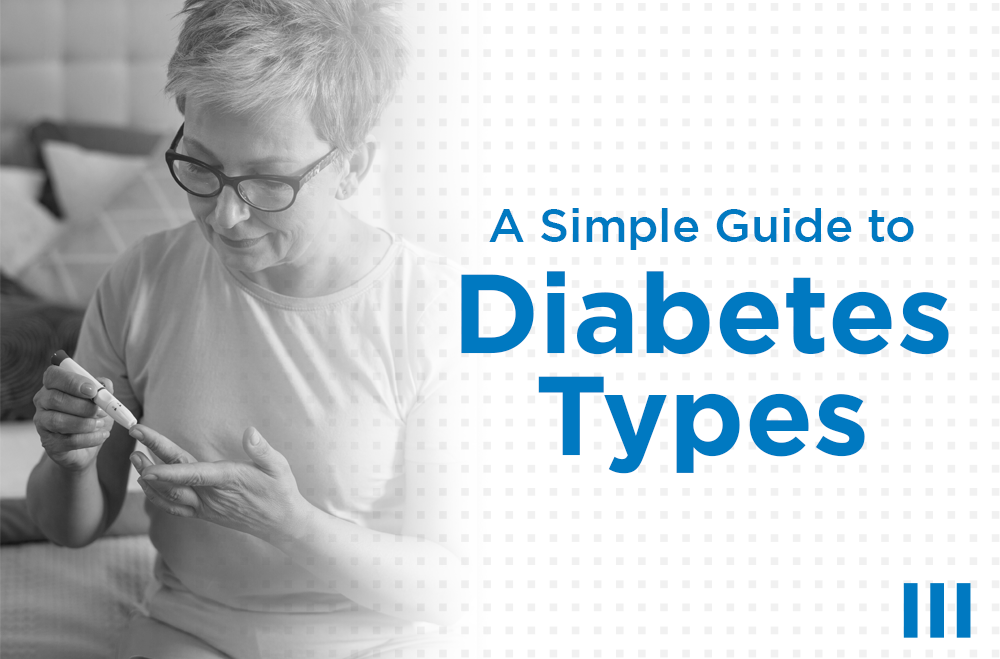Diabetes is a chronic condition that affects how your body turns food into energy. When you eat, your body breaks down food into sugar (glucose) and releases it into your bloodstream. Your pancreas, an organ behind your stomach, then produces insulin, a hormone that acts like a key, unlocking your cells to let glucose in for energy. However, when you have diabetes, your body either doesn’t produce enough insulin or can’t use the insulin it produces effectively. This leads to high blood sugar levels, which can damage your organs over time. We hope this simple guide to diabetes types empowers you to take charge of your health.
Types of Diabetes
There are three main types of diabetes: Type 1, Type 2, and Gestational Diabetes.
Type 1 Diabetes
Type 1 diabetes is an autoimmune disease where your body mistakenly attacks and destroys the insulin-producing cells in your pancreas. It can develop at any age, but often appears in childhood or adolescence. Treatment involves daily insulin injections or an insulin pump.
Common symptoms of Type 1 diabetes are:
- Frequent urination
- Excessive thirst
- Constant hunger, even after eating
- Extreme fatigue
- Blurred vision
- Slow-healing cuts or bruises
- Unexplained weight loss, despite increased appetite
Type 2 Diabetes
Type 2 diabetes, the most common type, occurs when your body doesn’t produce enough insulin or resists insulin’s effects. It’s often associated with lifestyle factors like obesity, physical inactivity, and family history. Treatment typically involves a healthy diet, regular exercise, and sometimes medication or insulin.
Some individuals with type 2 diabetes may have mild or no symptoms, making early detection challenging. Common symptoms of Type 2 diabetes are:
- Frequent urination
- Excessive thirst
- Constant hunger, even after eating
- Extreme fatigue
- Blurred vision
- Slow-healing cuts or bruises
- Tingling, pain, or numbness in the hands or feet
Gestational Diabetes
Gestational diabetes develops during pregnancy. Hormones from the placenta can interfere with your body’s ability to use insulin effectively. Pregnant women, especially those who are overweight or have a family history of diabetes, are at higher risk. Treatment often includes a healthy diet, exercise, and sometimes insulin.
Managing Diabetes
No matter the type, managing diabetes involves:
Regular blood sugar monitoring: Checking your blood sugar levels regularly to keep them within a healthy range.
Healthy Eating: Prioritize a low-carb, low-sugar diet to help regulate blood sugar levels. When consuming carbohydrates, ensure they come from sources high in fiber, such as whole grains and legumes.
Regular exercise: Aim for at least 30 minutes of moderate-intensity exercise most days of the week.
Medication: If prescribed by your doctor, taking medication as directed.
While diabetes can be a complex condition, it doesn’t have to limit your life. Millions of people around the world manage diabetes successfully. This simple guide to diabetes types can empower you to take charge of your health. By understanding your body’s needs, making healthy choices, and working closely with your healthcare team, you can live a full and active life.
Resources:
https://diabetes.org/about-diabetes
https://www.cdc.gov/diabetes/about/index.html
Disclaimer:
The Comanche County Memorial Hospital website does not provide specific medical advice for individual cases. Comanche County Memorial Hospital does not endorse any medical or professional services obtained through information provided on this site, articles on the site or any links on this site.
Use of the information obtained by the Comanche County Memorial Hospital website does not replace medical advice given by a qualified medical provider to meet the medical needs of our readers or others.
While content is frequently updated, medical information changes quickly. Information may be out of date, and/or contain inaccuracies or typographical errors. For questions or concerns, please contact us at contact@ccmhhealth.com.

